1;Introduction
The natural world is full of surprises, and sometimes, it presents moments that are hard to believe. One such instance is the shocking event of a snake eating a cat. This unusual predator-prey dynamic sparks curiosity and raises questions about how such an event could occur. Understanding this rare encounter can help us gain deeper insights into the behaviors of snakes and the ecological roles of both animals.
Nature is unpredictable, and such rare events offer valuable lessons about wildlife behavior. A closer examination of this incident provides a window into the complexities of ecosystems. The relationship between predators and prey is fundamental to maintaining ecological balance, but moments like this challenge our understanding of what is “normal” in the wild. Exploring the reasons behind such incidents not only satisfies human curiosity but also enhances our knowledge of biodiversity and its dynamics.

Additionally, this event underscores the need for coexistence with wildlife. As human activity encroaches on natural habitats, such encounters become more frequent, emphasizing the importance of conservation and education. By delving into the specifics of this rare occurrence, we can learn how to better protect both humans and animals while appreciating the intricate relationships that sustain life on Earth.
2;The Scene Unfolds
Where and How It Happened
The event reportedly took place in a rural area, where snakes often coexist with small mammals and domestic animals. In this particular case, a large snake, likely a python or boa, targeted a cat as its prey. The incident unfolded near a dense forest, providing the perfect environment for the snake to ambush its target.
Rural and forested regions are often hotspots for such interactions due to their proximity to both wildlife and human settlements. Snakes, being cold-blooded and highly adaptive, find these areas suitable for hunting. The dense vegetation offers cover, while the presence of domestic animals and rodents provides ample food sources. This particular event highlights the challenges of human-wildlife coexistence in transitional zones between urban and natural landscapes.
Moreover, the environmental factors at play are worth noting. The weather, time of day, and availability of prey all contribute to the likelihood of such an encounter. Snakes are most active during specific periods, such as dusk or early morning, when temperatures are favorable for their hunting activities. Understanding these patterns can help mitigate risks and promote safer interactions between humans, their pets, and wildlife.
Eyewitness Accounts
Eyewitnesses described the moment as both shocking and fascinating. The snake’s calculated approach and the cat’s unsuccessful attempt to escape highlighted the raw power of nature. Such encounters, while rare, remind us of the unpredictability of wildlife interactions.
Witnesses often play a crucial role in documenting such events, providing valuable insights into animal behavior. In this case, observers noted the snake’s stealth and precision, which are hallmarks of its hunting strategy. The cat’s reaction, characterized by initial confusion followed by a desperate escape attempt, underscores the challenges faced by prey animals in such situations.

These accounts also emphasize the emotional impact of such incidents on humans. Watching a predator-prey interaction unfold in real-time can evoke a mix of awe, fear, and sadness. For many, it is a stark reminder of the harsh realities of nature, where survival often comes at a high cost. By sharing these stories, eyewitnesses contribute to our understanding of wildlife and inspire efforts to promote harmony between humans and the natural world.
3;Understanding the Snake’s Behavior
Why Do Snakes Attack Unusual Prey?
Snakes are opportunistic predators. They hunt based on availability rather than specific preferences. When food is scarce, a snake may target prey that is not part of its usual diet. In this case, the cat’s movements likely triggered the snake’s predatory instincts.
Opportunistic behavior is a key survival strategy for snakes. Unlike mammals, snakes do not require frequent meals, as their slow metabolism allows them to digest large prey over extended periods. This adaptability enables them to survive in diverse environments, from rainforests to deserts. However, it also means that they may occasionally prey on animals outside their typical diet, especially when conventional food sources are limited.
The cat’s movements and size likely played a significant role in attracting the snake’s attention. Snakes rely heavily on their senses, particularly heat detection and movement, to identify potential prey. The cat’s warmth and rapid movements may have made it an appealing target, despite not being a common choice for the snake.
Hunting Techniques of Large Snakes
Large snakes like pythons and boas rely on constriction to subdue their prey. They strike quickly, coil around the target, and squeeze until the prey suffocates. This method allows them to tackle animals larger than themselves, including cats.
Constriction is a highly effective hunting technique that has evolved over millions of years. By using their powerful muscles, snakes can immobilize prey within seconds, minimizing the risk of injury to themselves. The process also ensures that the prey cannot escape, as the coils tighten with every breath the prey takes. This method is particularly advantageous when dealing with agile and potentially dangerous animals like cats.

Understanding the biomechanics of constriction sheds light on the snake’s efficiency as a predator. Studies have shown that the force exerted by a constricting snake is several times greater than the prey’s blood pressure, ensuring a swift and humane kill. This adaptation not only highlights the snake’s predatory prowess but also its role as an apex predator in its ecosystem.
4;The Cat’s Role in the Food Chain
Are Cats Typical Prey for Snakes?
Cats are not common prey for snakes, but they can become targets under certain conditions. Domestic cats venturing into snake habitats are at greater risk, especially in areas where large snakes are prevalent.
Domestic cats, while agile and equipped with sharp claws, are not invincible. Their tendency to explore and hunt in unfamiliar territories often brings them into contact with predators. In regions where snakes are abundant, cats may unknowingly venture into danger, increasing their vulnerability. This interaction serves as a reminder of the interconnectedness of all species within an ecosystem.
Furthermore, the role of domestic animals in the food chain is influenced by human activity. As humans expand into natural habitats, they inadvertently expose their pets to risks from wildlife. This incident underscores the need for responsible pet ownership, including measures such as keeping cats indoors or supervising them during outdoor activities.

Survival Strategies of Small Mammals
Small mammals, including cats, rely on agility and keen senses to avoid predators. However, when faced with ambush predators like snakes, their chances of escape can diminish significantly.
The survival strategies of small mammals are diverse and highly effective under normal circumstances. These include rapid reflexes, acute hearing, and the ability to climb or burrow. However, ambush predators like snakes exploit their prey’s vulnerabilities by striking with precision and speed. This interaction highlights the constant evolutionary arms race between predators and prey, where each adapts to outwit the other.
By studying these strategies, researchers gain valuable insights into the dynamics of predator-prey relationships. This knowledge not only enhances our understanding of wildlife behavior but also informs conservation efforts aimed at preserving the delicate balance of ecosystems.
5;Ecological Implications
Impact on Local Wildlife
This event highlights the intricate balance of predator-prey dynamics. While it may seem unnatural, such incidents are part of the ecosystem. They demonstrate the adaptability of predators like snakes in diverse environments.
What This Event Says About Predator-Prey Relationships
The encounter underscores the unpredictable nature of predator-prey interactions. It also sheds light on the adaptability of both predators and prey in the face of changing environments.
6;Rare but Real: Documented Cases
Similar Incidents in the Wild
While rare, there have been documented cases of snakes preying on unusual animals, including monkeys, dogs, and even deer. Such incidents often occur in regions where snakes are apex predators.
How Often Do Such Events Occur?
These events are uncommon but not unheard of. They typically happen in areas with high snake populations and limited food sources, forcing snakes to expand their prey selection.
7;Human Reactions and Media Coverage
Viral Stories of Unusual Wildlife Encounters
Events like a snake eating a cat often go viral due to their shocking nature. Videos and images shared online captivate audiences and spark discussions about wildlife behavior.
Public Perception and Misconceptions
While such incidents are natural, they often lead to misconceptions about snakes being overly aggressive or dangerous. It is essential to view these events within the context of natural behavior.
8;Expert Opinions
Wildlife Biologists on the Incident
Wildlife biologists emphasize that such encounters are rare and usually occur under specific conditions. They highlight the importance of preserving natural habitats to reduce human-wildlife conflicts.
Lessons Learned from Nature’s Rare Moments
These moments teach us about the resilience and adaptability of wildlife. They also remind us of the importance of coexisting with nature and respecting the roles of all species in the ecosystem.
9;FAQs
Why do snakes target unusual prey like cats?
Snakes are opportunistic predators that hunt based on availability rather than preference. When typical prey is scarce, they may target unconventional animals, like cats, whose movements and heat trigger predatory instincts.
What makes ambush predators like snakes successful?
Snakes rely on stealth, precision, and constriction to capture and subdue prey. Their quick strikes and powerful coils ensure their prey cannot escape, even if it’s an agile animal like a cat.
Why are predator-prey events like this rare?
Such events occur under specific conditions, like food scarcity or overlapping habitats. Domestic cats venturing into snake territories increase the likelihood of these rare interactions.
How do these encounters impact human perceptions of snakes?
Unusual events, such as a snake eating a cat, often lead to misconceptions about snakes being overly aggressive. These incidents should be viewed as natural behavior, emphasizing the need for ecological balance.
What lessons can be learned from such wildlife encounters?
These events highlight the adaptability of predators and prey, the complexity of ecosystems, and the importance of human-wildlife coexistence. Responsible pet ownership and habitat conservation can help reduce such interactions.
10;Conclusion
In conclusion, the rare event of a snake preying on a cat offers a fascinating glimpse into the complexities of predator-prey dynamics and the adaptability of wildlife. While shocking, such incidents remind us of the delicate balance that sustains ecosystems and the unpredictable nature of the wild. As human activity continues to encroach on natural habitats, understanding and respecting these interactions is crucial. By promoting conservation, responsible pet ownership, and coexistence, we can ensure a harmonious relationship with the natural world, appreciating its wonders while minimizing conflicts.
